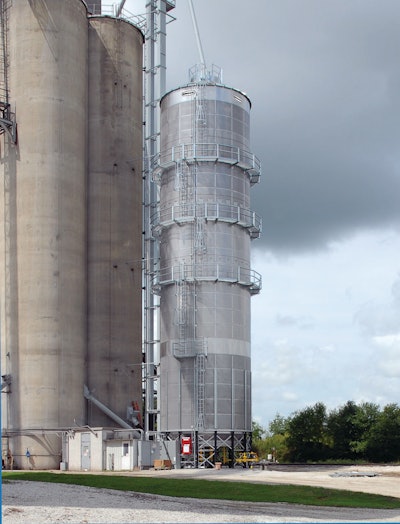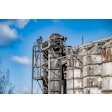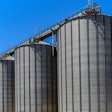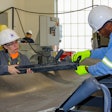
Fire safety is among the highest of priorities for feed and grain facilities. Fires can cause explosions, serious injury, property damage, facility downtime and financial loss. A proactive approach to preventing them in the first place is key to fire safety, and focuses on electrical maintenance, equipment temperature monitoring and regular fire risk assessments.
One potential fire risk is a grain dryer — if not properly maintained. Attentive monitoring of a grain dryer can’t be overstated for this reason, according to Bill Winchell, sales manager for Brock Grain Systems. Winchell said more than 90% of dryer fires are caused by improper maintenance and overdue cleaning.
Effective dryer cleaning minimizes the risk by removing material buildup, such as dust, stalks and leaves inside the dryer that can catch fire if they make contact with its burner.
Cleaning prevents combustible material from igniting
Keeping grain dryers clean ensures efficient, safe, and effective operations, protecting both the equipment and the grain being processed.
Winchell highlighted the following key elements of grain dryer fire prevention in the Feed & Grain webinar, SLAM 360: Grain dryer operation and maintenance safety tips:
- Monitor Air Pressure: Regularly checking the air pressure inside the dryer will help indicate when it needs cleaning. First, record the air pressure when the dryer is clean and operating normally, and then monitor it for departures from normal pressure readings. Winchell said the air pressure is measured in inches of water column, and when pressure changes can be observed in the water column, it is time to clean it.
“If your dryer doesn’t have an alarm for increasing air pressure, you should record the air pressure when the dryer is clean, the burner is on and in normal operation,” Winchell said. “Record that air pressure, and during the course of managing and monitoring your dryer, if you see the air pressure increase by one inch of water column, plan on cleaning the dryer. It does not need to be done immediately, but after you’ve seen that one-inch increase, clean the dryer the next time it shuts down.”
- Clean the Screens: The screens on screen dryers can harbor debris and dried material that could become an ignition source. To clean the screens, Winchell said the fan must remain on and the burner shut off. He recommends using a high-pressure washer or high-pressure air to blast away dirt and buildup. Running the fans helps keep the material out of the screens and blows it away. The fans also blow out any water from the high-pressure washer that might get into the grain. He said this surface water does not soak into the grain if it’s removed quickly.
Turning off the burner is equally as important.
“Material on a low-profile or tower dryer will fall through the air, and the fans can capture and pull some of that material into the dryer, blowing it up into the plenum,” Winchell said. “So, turn off the burner during the cleaning process. Leaving it on can cause material to catch fire and create an ignition source inside the dryer.”
After cleaning the outside of the screens with the fans on, turn it off and lock out the power to clean the inside of the screens. Most material inside the dryer is dry and powdery, Winchell said, so sweeping it down is the best way to remove it from screens. He said not to let buildup inside of the screens become any thicker than 1 inch, as that can cause airflow issues and increases the chance of a dryer fire.
Cleaning Mixed Flow Dryers:
- Mixed flow dryers require special attention because they get dirty inside and lack external screens.
- Shut down and empty the dryer before cleaning.
- Use high-pressure air to clean the internal ducts and avoid using water, which can create a sticky mess in the unload system.
- Pay special attention to corners where debris tends to collect.
- Maintain a Clean Surrounding Area: Keep the area around the dryer free of debris like leaves, paper and corn stalks. These can get sucked into the fans and could cause fires or clog the system. Regularly inspect and clean the surroundings to prevent external material from being blown into the dryer.
“Today’s combines clean grain well under favorable conditions, but poor conditions can lead to more debris in the bins, which ultimately ends up in the dryer,” Winchell said. “This material can build up and cause dryer fires as it becomes very dry and ignitable.”
- Routine Maintenance: Regularly schedule thorough cleaning sessions based on usage and environmental conditions. Ensure all parts of the dryer, including the fans and burners, are inspected and maintained to prevent buildup and ensure optimal operation.
5. Safety Precautions: Always turn off and lock out the power before performing internal cleaning. Follow all safety protocols to prevent accidents and ensure a safe working environment.
Following these steps will help keep grain dryers clean, efficient and safe. Winchell also highlighted the importance of employee training regarding fire prevention, and specifically, dryer maintenance.
“The new modern control systems allow dryers to run on their own,” Winchell said. “They monitor and protect themselves, but short of monitoring the air pressure increases, they don’t have a good way to tell how clean or dirty the dryer is. Training employees to know what to look for, such as the dryer starting to back-up the air pressure, starting to get dirty, is important. And train them to do the cleaning itself regularly.”


















